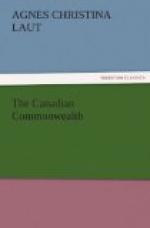While all this is of the past, the heritage of a fur-hunting ancestry has entered into the very blood and brawn and brain of Canada in a kind of iron dauntlessness that makes for manhood. Some of her greatest leaders—like Strathcona and MacKenzie—have been known as “Men of the North”; and whether they have fur-traded or not, nearly all those “Men of the North” who have made their mark have had the iron dauntlessness of the hunter in their blood. It is a sort of tonic from the out-of-doors, like the ozone you breathe, which fills body and soul with zest. Canada is sensitive to any reference to her fur trade for fear the world regard her as a perpetual fur domain. Her northern zones are a perpetual fur domain—we may as well acknowledge that—they can never be anything else; and Canada should serve notice on the softer races of the world that she does not want them. They can stand up neither to her climate nor to her measure of a man, but far from cause of regret, this is a thing for gratulation. Canada can never be an overcrowded land, where soft races crowd for room, like slugs under a board. She will always have her spacious domain of the North—a perpetual fur preserve, a perpetual hunting ground, where dauntless spirits will venture to match themselves against the powers of death; and from that North will ever emerge the type of man who masters life.
II
The last chapter of the fur trade has not been written—as many assert. The oldest industry of mankind, the most heroic and protective against the elements—against Fenris and Loki and all those Spirits of Evil with which northern myth has personified Cold—fur hunting, fur-trading, will last long as man lasts. We are entering, not on the extermination of fur, but on a new cycle of smaller furs. In the days when mink went begging at eighty cents, mink was not fashionable. Mink is fashionable to-day; hence the absurd and fabulous prices. Long ago, when ermine as miniver—the garb of nobility—was fashionable and exclusive, it commanded fabulous prices. Radicalism abolished the exclusive garb of royalty, and ermine fell to four cents a pelt, advanced to twenty-five cents and has sold at one dollar. To-day, mink is the fashion, and the little mink is pursued; but to-morrow fashion will veer with the caprices of the wind. Some other fur will come into favor, and the little mink will have a chance to multiply as the ermine has multiplied.




